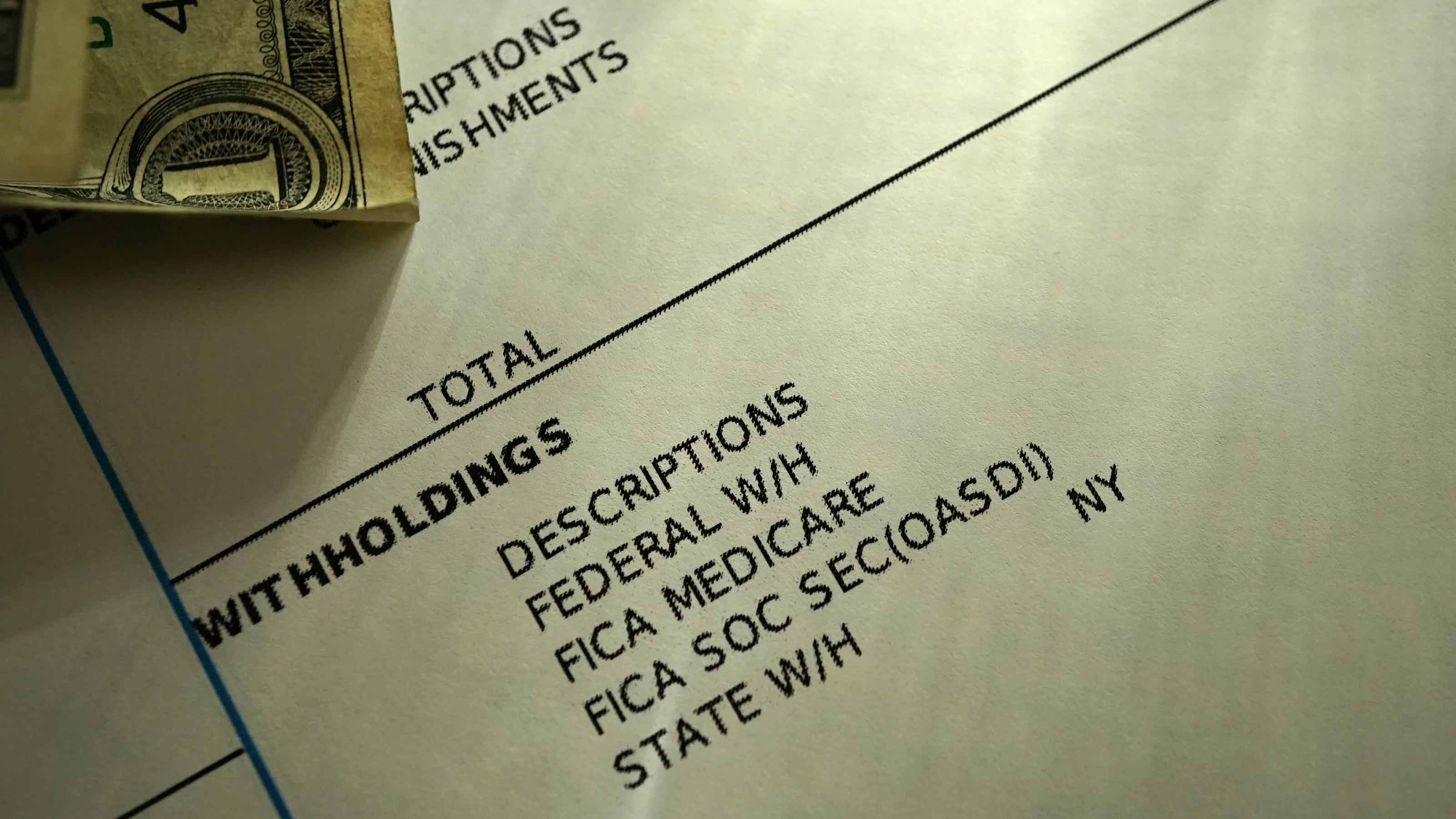2023 Social Security Tax Wage Base
Wealthier Americans will have more Social Security taxes taken from their paychecks next year because more of their income will be subject to the tax.


Many people don't realize that the Social Security tax that's withheld from each paycheck stops once your income exceeds a certain amount known as the "Social Security wage base." For instance, the Social Security wage base for 2022 is $147,000. So, if your income exceeds that amount this year, you don't pay the Social Security payroll tax on anything above $147,000. (Note: Social Security taxes are also known as Old-Age, Survivors, and Disability Insurance taxes, or OASDI taxes.)
More: Social Security Tax Wage Base Jumps 5% for 2024
This can be a significant tax cut for people earning more than the wage base. The tax rate for an employee's portion of the Social Security tax is 6.2%, so that's a pretty good savings for higher-income workers. (Your employer also pays 6.2% on any taxable wages, and you pay the full 12.4% if you're self-employed…although self-employed people can deduct part of that amount). For example, an employee with an annual salary $10,000 above the wage base saves $620, a worker with wages $30,000 over the base gets a $1,860 tax break, wages exceeding the base by $50,000 results in a $3,100 tax cut, and so on and so on. The more you make in excess of the wage base, the more money you save on Social Security taxes.
From just $107.88 $24.99 for Kiplinger Personal Finance
Become a smarter, better informed investor. Subscribe from just $107.88 $24.99, plus get up to 4 Special Issues

Sign up for Kiplinger’s Free Newsletters
Profit and prosper with the best of expert advice on investing, taxes, retirement, personal finance and more - straight to your e-mail.
Profit and prosper with the best of expert advice - straight to your e-mail.
However, the Social Security wage base goes up each year that the national average wage index increases. When that happens – which is almost every year – more income is subject to the Social Security tax. Over the past five years, the wage base has gone up an average of $3,960 per year. But the wage base is going from $147,000 in 2022 to $160,200 in 2023. That's a year-over-year increase of $13,200 – the largest ever (just under a 9% increase) by a wide margin.
As a result, the maximum Social Security tax possible jumps from $9,114 to $9,932. So, for people making over $160,200 in 2023, they will be paying $818 more in Social Security taxes next year than they would have paid if the wage base remained at $147,000 ($573 more if the wage base grew at the average rate over the past five years). That's a significant increase by historical standards.
Of course, people earning under $160,200 in 2023 will have to pay Social Security taxes on all of their wages. Plus, if you make between $147,000 and $160,200 in 2023, you may be paying Social Security taxes on all your income for the first time (or the first time in a while).
Exemptions From Social Security Taxes
Some people aren't required to pay Social Security taxes. For instance, exemptions from Social Security taxes may be available if certain requirements are met for:
- Ministers and church employees;
- Members of certain religious groups (e.g., the Amish and Mennonites) who waive their rights to all Social Security benefits;
- Students employed by their school;
- Foreign students temporarily in the U.S. under certain types of visas;
- Minors employed in a family business;
- Non-citizens working for a foreign government in the U.S.; and
- Self-employed people with less than $400 of self-employment income.
Other exemptions may also apply.
Other Taxes Withheld From Your Paycheck
Take a look at your most recent pay stub. You'll notice that there are other taxes withheld from your paycheck other than the Social Security tax. For example, federal income tax is withheld from your pay, because Uncle Sam like to get his cut a little bit at a time (the amount is based on what you reported to your employer on Form W-4). State income taxes will also be withheld, unless you live in a state without an income tax.
You also have a Medicare tax taken out of your wages. This tax is equal to 1.45% of your pay. Unlike the Social Security tax, there is no cap on wages to which the Medicare tax applies. So, even if you earn more than $160,200 in 2023, you'll pay the 1.45% Medicare tax on all your wages. In fact, if you make too much money, you have to pay even more in Medicare taxes. That's because workers must also pay an additional 0.9% Medicare surtax on wages (and self-employment income) over $200,000 for singles and $250,000 for married couples filing a joint tax return ($125,000 for a married person filing a separate return).
(Note: Together, Social Security taxes and Medicare taxes are also known as Federal Insurance Contributions Act taxes, or FICA taxes.)
Profit and prosper with the best of Kiplinger's advice on investing, taxes, retirement, personal finance and much more. Delivered daily. Enter your email in the box and click Sign Me Up.
Rocky Mengle was a Senior Tax Editor for Kiplinger from October 2018 to January 2023 with more than 20 years of experience covering federal and state tax developments. Before coming to Kiplinger, Rocky worked for Wolters Kluwer Tax & Accounting, and Kleinrock Publishing, where he provided breaking news and guidance for CPAs, tax attorneys, and other tax professionals. He has also been quoted as an expert by USA Today, Forbes, U.S. News & World Report, Reuters, Accounting Today, and other media outlets. Rocky holds a law degree from the University of Connecticut and a B.A. in History from Salisbury University.
-
 Santa Claus Rally at Risk as Tech Stocks Slump: Stock Market Today
Santa Claus Rally at Risk as Tech Stocks Slump: Stock Market TodayThe Nasdaq Composite and Dow Jones Industrial Average led today's declines as investors took profits on high-flying tech stocks.
-
 7 Ways to Save Money on Almost Everything
7 Ways to Save Money on Almost EverythingHigh prices got you down? These strategies can help you reap deep discounts on everyday spending.
-
 My Top 10 Stock Picks for 2026
My Top 10 Stock Picks for 2026Each year, we ask an expert to pick 10 stocks that have the potential to beat the market over the next 12 months. Here are his choices for 2026.
-
 Retirees in These 7 States Could Pay Less Property Taxes Next Year
Retirees in These 7 States Could Pay Less Property Taxes Next YearState Taxes Retirement property tax bills could be up to 65% cheaper for some older adults in 2026. Do you qualify?
-
 Estate Tax Quiz: Can You Pass the Test on the 40% Federal Rate?
Estate Tax Quiz: Can You Pass the Test on the 40% Federal Rate?Quiz How well do you know the new 2026 IRS rules for wealth transfer and the specific tax brackets that affect your heirs? Let's find out!
-
 5 Types of Gifts the IRS Won’t Tax: Even If They’re Big
5 Types of Gifts the IRS Won’t Tax: Even If They’re BigGift Tax Several categories of gifts don’t count toward annual gift tax limits. Here's what you need to know.
-
 The 'Scrooge' Strategy: How to Turn Your Old Junk Into a Tax Deduction
The 'Scrooge' Strategy: How to Turn Your Old Junk Into a Tax DeductionTax Deductions We break down the IRS rules for non-cash charitable contributions. Plus, here's a handy checklist before you donate to charity this year.
-
 Are You Middle-Class? Here's the Most Tax-Friendly State for Your Family
Are You Middle-Class? Here's the Most Tax-Friendly State for Your FamilyTax Tips We found the state with no income tax, low property tax bills and exemptions on groceries and medicine.
-
 Social Security Benefits Quiz : Do You Know the IRS Tax Rules?
Social Security Benefits Quiz : Do You Know the IRS Tax Rules?Quiz Social Security benefits often come with confusing IRS tax rules that can trip up financially savvy retirees and near-retirees.
-
 How Are I Bonds Taxed? 8 Common Situations to Know
How Are I Bonds Taxed? 8 Common Situations to KnowBonds Series I U.S. savings bonds are a popular investment, but the federal income tax consequences are anything but straightforward.
-
 Capital Gains Tax Quiz: How Well Do You Really Know IRS Investment Tax Rules?
Capital Gains Tax Quiz: How Well Do You Really Know IRS Investment Tax Rules?Quiz Take our capital gains tax quiz to test your investment taxes knowledge. Learn about loss rules, holding periods, and tax incentives that could impact your savings.
